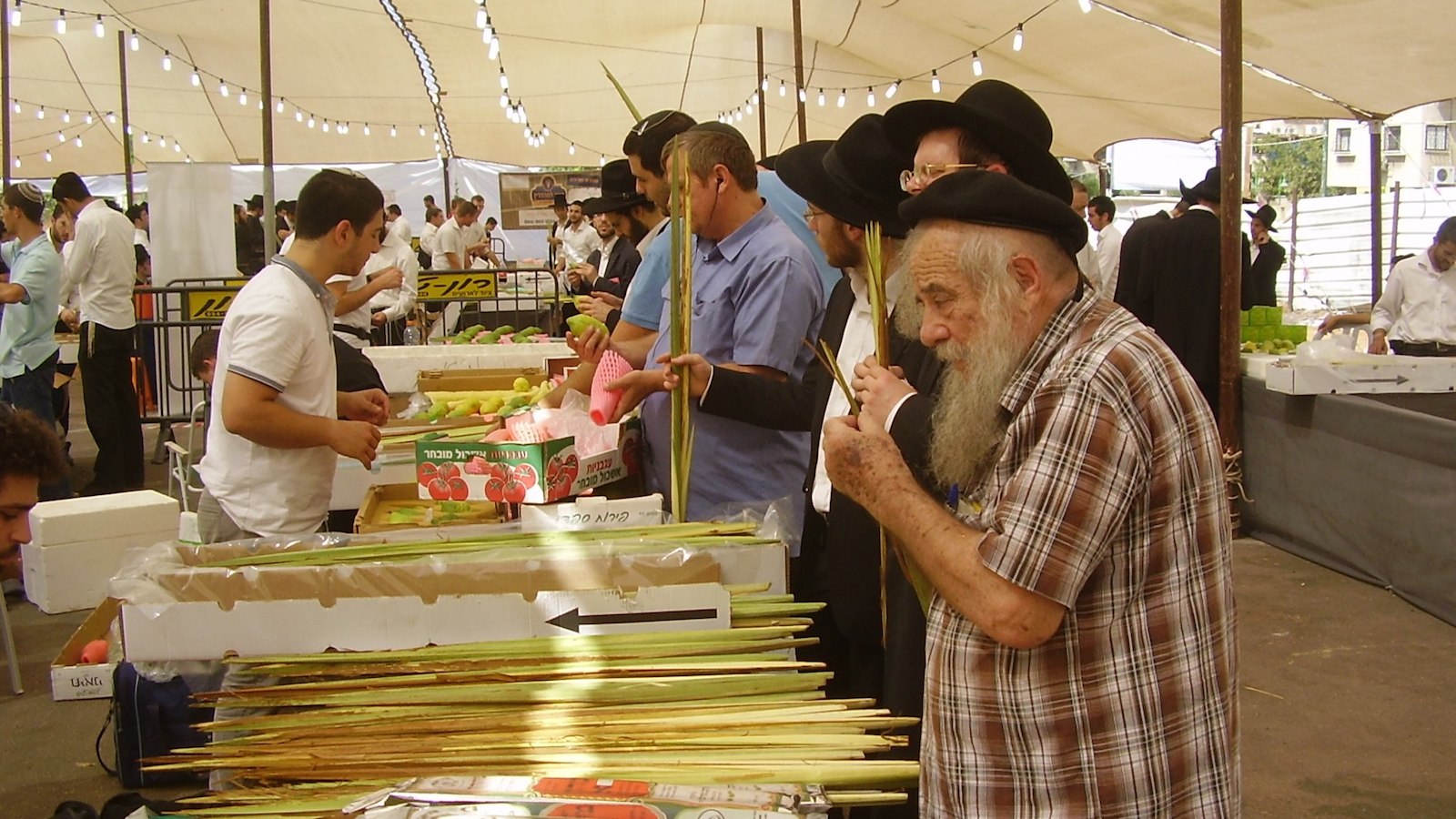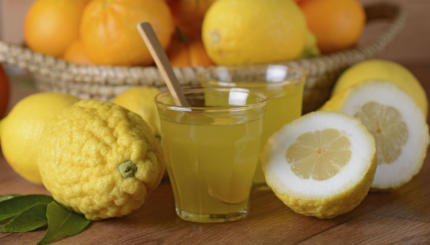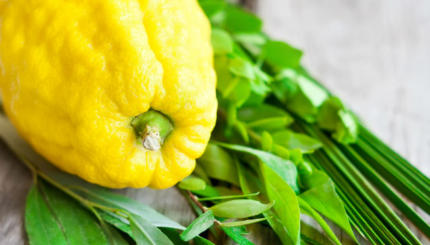With regard to selecting the lulav and etrog, there is an operative principle involved called hiddur mitzvah. This is a bit difficult to explain. Essentially it entails going beyond the specification for the “legal” minimum-to select the most beautiful, elegant, and as nearly perfect fruits as possible.
Lulavs and etrogs are sold in most Judaica stores in the weeks before Sukkot. You can also purchase lulavs and etrogs online.
Thus, although there are relatively few categories of absolutely unacceptable species, there are many criteria–we’ll discuss these soon–relating to the level of beauty of the species. Much of the fun of buying sets is in making your own evaluations and selecting the best among large varieties. After knowing what the criteria are, choose what you like. You are the one who is going to have to live with your lulav and etrog for seven days.
The Etrog
You must pay the greatest attention to the selection of the etrog. Compared to selecting an etrog, choosing a lulav is like an afterthought. Begin the buying process with the selection of the etrog, then the lulav, then the myrtle, then the willows. It is with the etrog that the greatest variation exists and the greatest obligation for hiddur mitzvah–beauty– applies (based on the etrog being “the product of the hadar [beautiful] trees”).
With your help, My Jewish Learning can provide endless opportunities for learning, connection and discovery.
It must have a pitom [a piece of the stem protruding from the end of the etrog]; there are some varieties which do not grow a pitom to begin with and are therefore usable. But if you have an etrog without a pitom, make sure that it is from such a variety and that the pitom did not simply fall off.
It should be a good yellow color.
It should have a pleasing, basically symmetrical, oblong shape.
It should not have little black spots on it or any permanent discoloration or disfiguration (rub your nail over it to see if spots will come off). An etrog without any discoloration or black spots at all is very expensive and almost impossible to find. Still, these imperfections should definitely be avoided around the top third of the fruit (toward the side of the pitom).
For even greater elegance, there should be lengthwise ridges extending from the bottom toward the pitom. It is also good if the skin is sort of evenly bumpy. Again, the choice is yours as to what is and is not a beautiful etrog-color, shape, size, smell, weight, etc.
The Lulav
The lulav is from a palm tree and is held together with a willow branch and a myrtle branch.
It should be fresh — i.e., not dried up. It should be at least four tefahim (approximately 14″) long so that it will shake well. Its backbone — a solid ridge from which the leaves spread–ideally should extend from the bottom all the way to the top.
So that the leaves of the palm do not spread out obtrusively, the lulav should be bound at three points along its length. The bands are made from its leaves. If they are not already on the lulav, you can ask the seller to bind them for you, or you can improvise a bind yourself. (The three bands represent Abraham, Isaac, and Jacob; creation, revelation, redemption…) Aside from this, it should have a good feel in your hand and possess whatever other qualities you feel a lulav should possess–e.g., good spring, length, tight leaves, loose leaves, a thick backbone, a thin backbone.
When you buy it ask for a plastic bag to keep it in. This will be used to preserve its freshness and protect it throughout the holiday.
The Myrtle
They should be at least three tefahim (approximately 10″) long. There must be three branches.
The leaves of the myrtle, ideally, should grow in clusters of three at every spot on the stem. Often, however, the three leaves do not emanate from the exact same spot on the stem. You should select myrtle branches which have at least three clusters of three emanating from single spots-preferably near the top.
The Willow
They should be at least three tefahim (approximately 10″) long. There must be two branches.
The leaves of the willow, ideally, should grow in clusters of two at every spot on the stem. Often, however, the two leaves do not emanate from the exact same spot on the stem. You should select willow branches which have at least two clusters of two emanating from single spots-preferably near the top.
How To Care For 4 The Species
Until you have to assemble them, store the parts separately. The etrog will come wrapped in a padding material and enclosed in a box. Make sure to keep it wrapped in this, with the pitom well protected. If you have a separate etrog box, store it there. Otherwise, keep it in its box and in a safe place. It is advisable, although not necessary, to keep it in the refrigerator. The etrog has an amazing quality: It will not rot. It will dry up, but not spoil. The myrtle and willow will spoil and should be kept in the refrigerator wrapped in a wet towel. These will dry up and the leaves will fall off. So handle them with care. Avoid overhandling them. Once they are squeezed into the little holder gadget that comes with the lulav, it is best not to remove them, as this will generally rip the lower leaves off.
Rather than do this, either:
- Take off the entire holder, wrap the leaves in a wet towel, and store in the refrigerator; or
- Slip the whole lulav with the holder and branches into the plastic bag, put a little bit of water in the bottom of the bag, seal (tie) the top. It can be left out as is or stored in the refrigerator.
The lulav will generally stay fresh for at least the seven days without special care required of it.
What To Do With Them Afterward
What to Do with the Lulav, Myrtle and Willow
Virtually nothing can be done with the myrtle and willow. Until it dries up the myrtle can be used for besamim, spices, for Havdalah. The lulav can be:
- Used for decoration. It has a certain slim elegance and graceful dignity to it.
- Saved and waved on Hanukkah (see 2 Maccabees 10:5-8).
- Saved and used in place of a feather for searching out the hametz [leavened items] before Passover. Then burn it with the hametz.
What to Do with the Etrog
The etrog has a number of wonderful uses after its need during the holiday is exhausted:
Etrog Marmalade
Collect etrogs from friends and make etrog marmalade: Slice etrog into thin cross-sections. Place in a pot or bowl of water for four days or so. Change the water every day. This serves to take out some of the abundant bitterness and acidity of the etrog. For the curious, try tasting a bit of the water on the second or third day. After this process, proceed with any marmalade, jelly, or preserves recipe. You may have to add oranges for volume. Even if the etrog is but a small part of the whole, it is worth the effort.
Etrog Wine
Try these etrog recipes from The Nosher.
Etrog recipes from the Jerusalem Post
Etrog Potpourri
Stick a lot of whole cloves into the etrog. Cover totally with powdered cinnamon and let dry for a few weeks. You will then have a wonderful spice essence. Use it for Havdalah. Let it cast its fragrance in a closet. Give it to a friend.
Reprinted with permission from The Jewish Catalogue: A Do-It Yourself-Kit, edited by Richard Siegel, Michael Strassfeld and Susan Strassfeld, published by the Jewish Publication Society.
etrog
Pronounced: ETT-rahg, Origin: Hebrew, a citron, or large yellow citrus fruit that is one of four species (the others are willow, myrtle and palm) shaken together as a ritual during the holiday of Sukkot.
Hanukkah
Pronounced: KHAH-nuh-kah, also ha-new-KAH, an eight-day festival commemorating the Maccabees' victory over the Greeks and subsequent rededication of the temple. Falls in the Hebrew month of Kislev, which usually corresponds with December.
lulav
Pronounced: LOO-lahv (oo as in boo), Origin: Hebrew, a bundle of branches representing three species -- willow, myrtle and palm -- which are shaken together with the etrog on Sukkot.
hametz
Pronounced: khah-METZ or KHUH-metz, Origin: Hebrew, bread or any food that has been leavened or contains a leavening agent. Hametz is prohibited on Passover.
Havdalah
Pronounced: hahv-DAHL-uh, Origin: Hebrew, From the root for "to separate," the ceremony marking the end of Shabbat and the beginning of the week.


